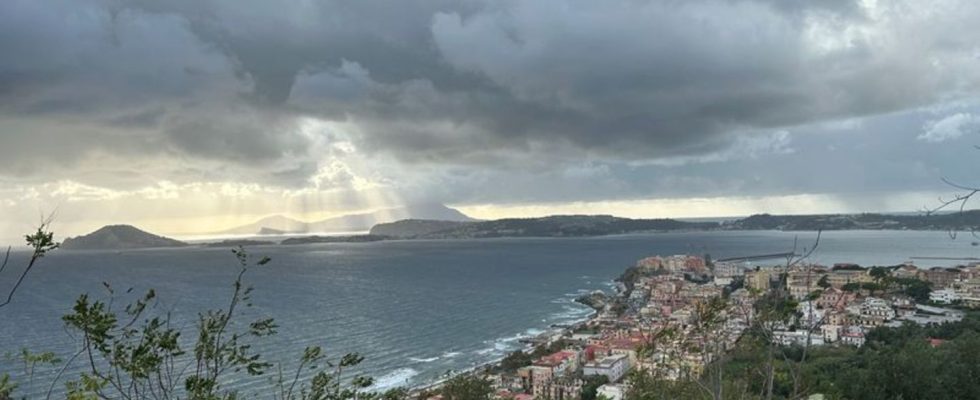Disasters
Fear plays a role – Naples worried about supervolcano
The town of Pozzuoli lies on the Campi Flegrei supervolcano, where experts fear worse after a series of earthquakes. photo
© Christoph Sator/dpa
Etna in Sicily, the Reyjkanes peninsula in Iceland – Europe’s volcanoes are currently very active. According to experts, the greatest danger lies in the densely populated area around Naples.
The Montefusco Spinesi sports field is not one where great successes are celebrated. An artificial turf in a suburb of Naples, more black than green, thick plastic sheets behind the goal, the stands just concrete. A place like many in Italy.
What makes Montefusco Spinesi so special: Football is played here in the middle of what is probably Europe’s most dangerous volcano. This evening again clouds of smoke rise from the ground nearby. It smells like rotten eggs. People are used to that. But recently her worries have increased significantly.
The densely populated region in the west of the megacity has been shaken by small and large earthquakes for months: more than 1,500 since the beginning of September alone. Usually only a tremor lasting a few seconds, sometimes accompanied by a rumbling underground, without anything major having happened so far. But the strongest quake had a magnitude of 4.2. Many residents fear that these are signs of an outbreak. Gerardo Cerino (55), who is watching his son at soccer training, says: “I grew up here. But the fear has been playing out for a few weeks.”
The danger in the ground
The area here has the danger in its name: Campi Flegrei. Literally translated: Burning fields. Science, with a little more restraint, has turned this into the Phlegraean Fields. The local volcano is not a well-formed mountain like Vesuvius, which has dominated Naples’ panorama so beautifully since its spectacular eruption on Pompeii in 79. On the Campi Flegrei the danger lies dormant in the ground, you can’t see it: a total of 150 square kilometers of dents and craters, largely hidden in the sea.
On the mainland, the risk is best sensed in the port town of Pozzuoli, a few kilometers from the soccer field. In the Solfatara crater field, the earth is bubbling away, smoke is rising, the water vapor is mixed with carbon dioxide and sulfur – hence the rotten egg smell. Until a few years ago, the Solfatara was a tourist attraction. It has been a restricted area since 2017, when a couple with their eleven-year-old son died in the field. The spectacle can now only be viewed from a hill. Next to it is a luxury hotel with a view far out to sea.
39,000 years ago, this was the site of the largest volcanic eruption on the European continent in the last hundred thousand years. At that time, almost all life was destroyed in large parts of what is now southern Italy. The ash flew into what is now Russia. From these times, the term supervolcano for the Campi Flegrei is justified. Supervolcanoes are characterized by a particularly large magma chamber and enormous violence: unlike normal volcanoes, they literally explode.
The last eruption on the Campi Flegrei was almost half a millennium ago: in 1538. Previously, the ground had gradually risen by several meters over a period of 70 years due to surges of magma. The scenario is the same today: the ground has been bulging again for seven decades. In Pozzuoli you can see this because the quay wall in the harbor is a few meters higher than before: fishermen have difficulty reaching it from their boats.
Increased vigilance has been in place since 2012
In the observatory of the National Institute of Geophysics and Volcanology (IGNV) in Naples, everything is monitored closely: the earthquakes, the rise and fall of the ground, the composition of the smoke. Geophysicist Giovanni Macedonio is standing at one of the screens. “This is probably the most observed volcano in the world,” says the 64-year-old. Based on the data, most experts expect the bottom to continue to bulge. This means: more tension, more cracks, more fractures, more tremors. Until at some point it might become too much.
But when, what and whether anything will happen at all, no one knows. It doesn’t have to be an eruption. It is also possible that there is a severe earthquake or a steam explosion in the middle of the city with dire consequences. But it is also conceivable that the supervolcano will almost completely calm down again. Either way: Macedonio is confident that the population can be brought to safety in time if the worst comes to the worst. 48 hours should be enough to evacuate more than 360,000 people who live in the immediate danger zone.
Since 2012, the region has been on a yellow alert – increased vigilance. After the many earthquakes in recent months, there is now speculation that it will soon be raised to orange. The Civil Protection Minister of the Italian right-wing government, Nello Musumeci, has already indicated this. It has already been decided in Rome that civil protection for the Campi Flegrei will receive an additional 52 million euros.
In the neighborhood, people are preparing to be on the safe side. The housewife Silvana Di Dio (36) is one of those who have already packed a suitcase. He’s standing in the hallway at home. “Just the bare necessities: clothes, medication, cosmetics. We’ll be ready to leave in ten minutes,” says the mother of two children. The parish of San Gennaro on the Solfatara has also already taken precautions. The church door now remains open during church services. This way, if something happens, the believers should get outside more quickly.

